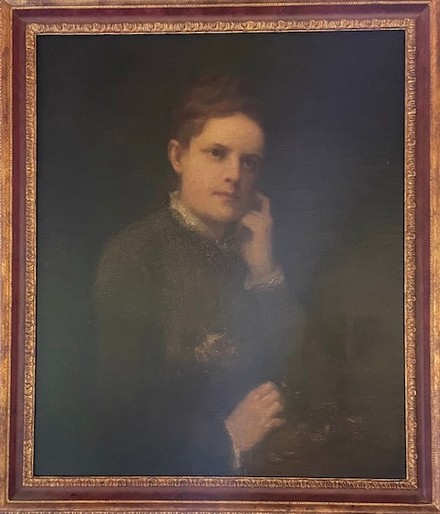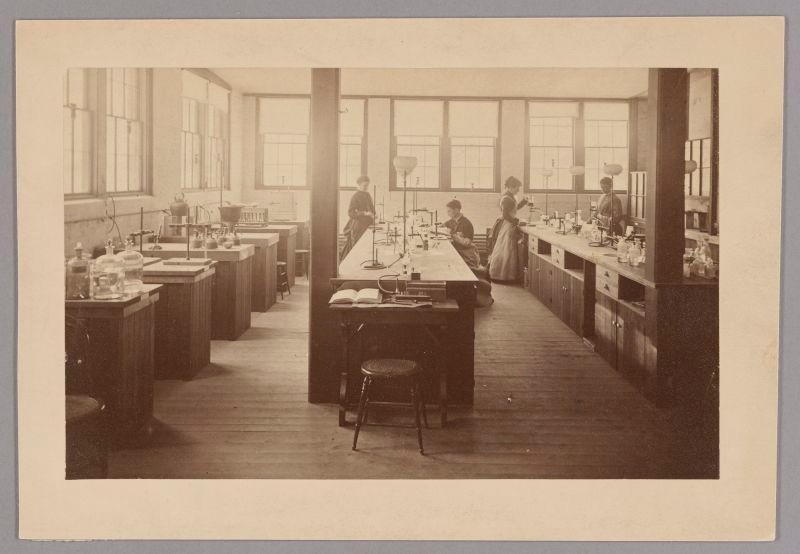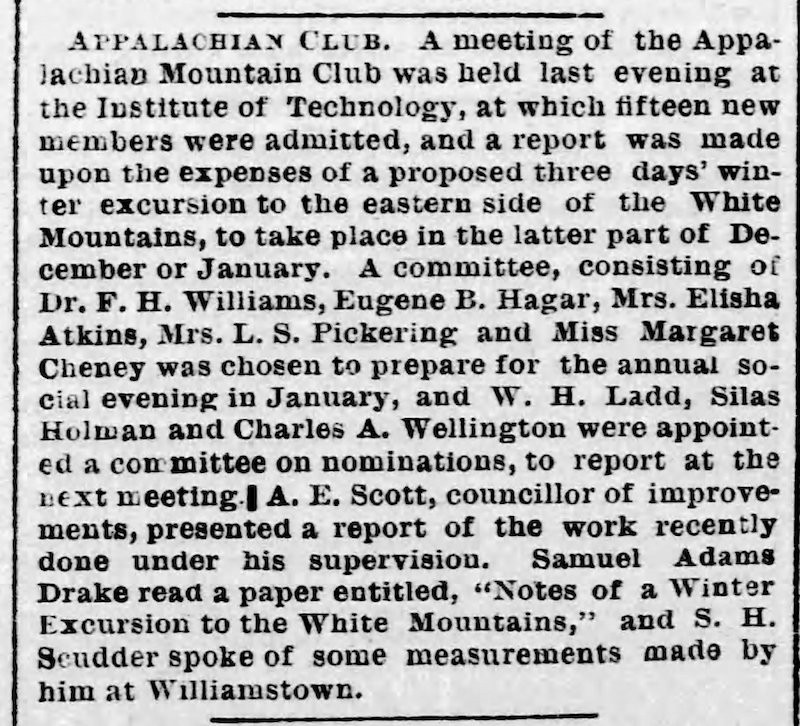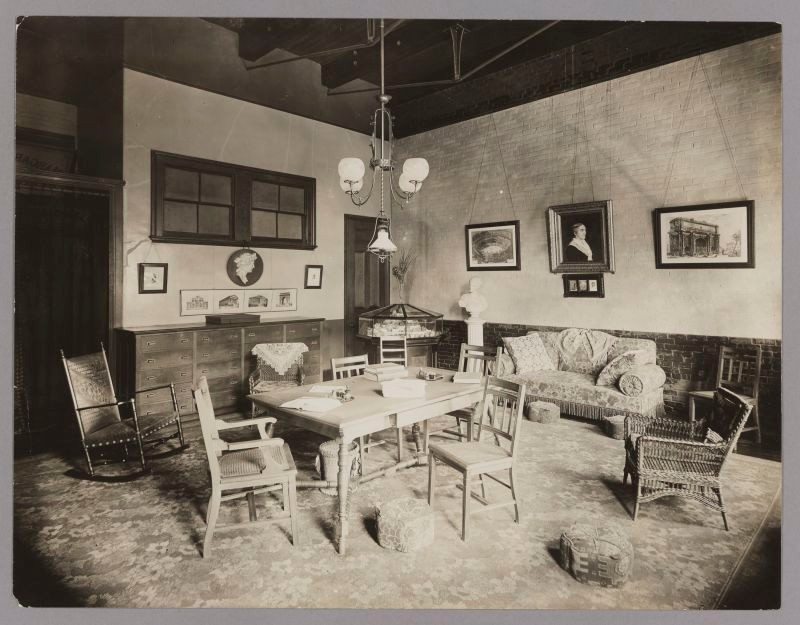Margaret Swan Cheney - More Than a Portrait on the Wall
Introduction
Text-to-speech Audio
Margaret Swan Cheney was part of the circle of women scientists, educators, and advocates who became MIT’s First Women. Margaret was born in Manchester, CT, to Seth and Ednah Cheney on September 8th, 1855. Soon after Seth died in 1856, Margaret and Ednah moved to Jamaica Plain, often returning to Manchester to spend summers with “the cousins.” As a youngster, Margaret’s favorite subjects were Science and History. As she grew older, she enjoyed demonstrating “simple experiments, such as the precipitation of camphor and the effervescence of acids and alkalis.” Her propensity for eruptive experiments earned her the nickname “Professor of Chemistry.”3
Learn more about this young woman.
Images
Margaret Swan Cheney, oil painting completed by George Fuller in 1884, from her graduation photograph

Ednah and Margaret Cheney, NEW ENGLAND WOMEN'S CLUB, ca. 1868-1875.

The chemical laboratory at Massachusetts Institute of Technology, Boston: women and men at class. Wood engraving, c 1880.

Women's Laboratory (1876-1883)

Appalachian Club, Boston Evening Transcript, 16 Dec. 1881.

Margaret Cheney Room (1884)

Backstory and Context
Text-to-speech Audio
As a teenager, Margaret attempted to discover the exact temperature of their oven and ruined “two expensive thermometers.” To better channel this curiosity, Margaret undertook advanced studies in Latin, Chemistry, and Vegetable Physiology with Augusta R. Curtis in 1872. Augusta was more than a tutor. When Margaret and Ednah first moved to Jamaica Plain in 1856, Augusta stayed with them for almost two years and, in Ednah’s words, “helped to make the empty house a home.” 3,5
Born in 1831, Augusta describes herself as a school teacher in Census records. The Lowell Free Lectures, open to men and women, offered teachers like Augusta the best opportunity for advanced instruction. Established in 1836, the Lowell Lectures did not start at MIT until 1866. Augusta was among the first to enroll in the Chemical Manipulation course MIT Professors Eliot and Storer led. As the session wrapped up in January 1867, Augusta and several other women inquired about registering at MIT for more advanced instruction. Their request was turned down.17, 14, 12, 13, 9
The following year, Augusta’s professors published The Manual of Chemistry. A bestseller, the book fueled demand for lab-based instruction in science. The Manual of Chemistry guided Margaret as she studied Chemistry in an attic lab. She was joined by Lucia Peabody, who, in December 1873, would be among the first women elected to the Boston School Committee, and Cora Clarke, who, as a recognized Entomologist, presented papers to the Massachusetts Horticultural Society and donated specimens to the Smithsonian. Journal articles through the early 1900s would cite Cora’s work as unique and foundational. At eighteen, Margaret was finally eligible to attend the Lowell Lectures. Her classes included hands-on lab exercises and field trips. The Lowell Free Lectures were the only access to formal scientific education for women like Augusta and Margaret.8,14,15,7
Meanwhile, in December 1870, MIT admitted its first woman, Ellen Swallow, as an “experiment.” Ellen became the first woman to earn a Bachelor of Science from MIT on May 31, 1873. Despite Ellen’s success, MIT stubbornly refused to admit other women citing a lack of lab space and inappropriate accommodations for women – translation, no ladies' restrooms. Ellen was more than an exception; she soon became an exceptional advocate for women at MIT. She proposed establishing a program to teach laboratory techniques to women. MIT agreed to donate the space if Ellen could raise the money and make the program self-sufficient. With financial support from the Women’s Education Association (WEA), Ellen established the MIT Woman’s Laboratory in 1876, knocking down the first barrier to women: Insufficient lab space.8,18
Margaret and Lucia were among the first women to register. Less than a year later, Margaret and Ellen co-authored a paper listing Margaret as the primary contributor. First published in the American Journal of Science and Arts, the article was translated and published in academic journals, reviewed in Popular Science, and cited by the US Geological Survey. Ellen co-authored other papers with her students, but this may be the only time the student’s name is listed first. Like students today, Margaret took time off from her studies to travel. On trips to North America and Europe, Margaret mastered new languages, collected botanical samples, and hiked in the mountains. In 1881, while Margaret was traveling, MIT opened the Chemistry S.B. program to women. However, Margaret died in September 1882 before she could complete her degree.9,6,3
Many of the women who came to the Woman’s Lab were teachers. In the 1880 Census, Margaret described herself as a “Teacher of Botany.” She taught classes at Jamaica Plain public schools, and on visits to Manchester, Margaret taught Chemistry and Botany to her cousins. She inspired a love of learning and exploration in her students. After a class about fermentation, two of her students returned with a sample of CO2 “collected from the bung-hole of a barrel of new cider.”17,3
In 1883, MIT tore down the Woman’s Lab to make room for a new building with expanded classroom and lab space. Troubled about future opportunities for women students at MIT, Ellen and Ednah, with MIT Alumnae and the WEA support, raise funds to provide a dedicated space for women with appropriate restroom facilities – the last barrier. MIT accepted the donation and the women’s condition - women must now be eligible for admission to MIT in all departments. The space, named in honor of Margaret Swan Cheney, opened in 1884. 9,8,18
In her will, Ednah established a fund to support the Margaret Cheney Room and donated the oil painting of Margaret that hangs in the Cheney Room today. However, Margaret is more than a portrait on the wall. A charter member of the Appalachian Mountain Club, she hiked to the top of Mount Adams in 1876. The American Association for the Advancement of Science elected Margaret and Cora for membership in 1880. Margaret also mentored women taking correspondence classes through the Society to Encourage Studies at Home, established by Ellen.11,1,10,8
Margaret was an explorer, scientist, and educator.
Cite This Entry
Smith, Coleen. "Margaret Swan Cheney - More Than a Portrait on the Wall." Clio: Your Guide to History. August 5, 2023. Accessed April 11, 2025. https://theclio.com/entry/167884
Sources
- Active Members in Appalachia, Vol. 1, No. 1 (June 1876).
- Bever, Marilynn. “The Women of M.I.T., 1871-1941 : Who They Were, What They Achieved.” MIT Libraries | DSpace@MIT, 1976, http://hdl.handle.net/1721.1/33804. Accessed 14 Mar. 2022.
- Cheney, Ednah Dow Littlehale. Memoir of Margaret Swan Cheney (Boston: Lee and Shepard), 1889. https://archive.org/details/memoirofmargaret00chen. Accessed 13 May 2022.
- Cheney, Ednah Dow Littlehale. Memoir of Seth W. Cheney, Artist. Boston: Lee and Shepard, 1881. https://hdl.handle.net/2027/gri.ark:/13960/t2b87qr0d. Accessed 05 Dec. 2022. [Father, drawing of the house she was born in.]
- Cheney, Ednah Dow Littlehale. Reminiscences of Ednah Dow Cheney (born Littlehale). Boston: Lee & Shepard, 1902. https://hdl.handle.net/2027/loc.ark:/13960/t3611jn48. Accessed 5 Dec. 2022.
- Cheney, Margaret S. and Richards, Ellen H., “A new and ready method for the estimation of nickel in pyrrhotites and mattes.” American Journal of Science and Arts, Vol. XIV., September 1877. https://archive.org/details/mobot31753002152921/page/178/mode/2up. Accessed 16 Feb. 2023. a. Chemical news and journal of industrial science. London: Chemical news office, Oct 5, 1877. https://hdl.handle.net/2027/mdp.39015012361062?urlappend=%3Bseq=171%3Bownerid=13510798895522350-213. Accessed 18 Feb. 2023. [Reprint]. b.The Popular science review: a quarterly miscellany of entertaining and instructive articles on scientific subjects. London: Robert Hardwicke. v. 17. Published1881. https://hdl.handle.net/2027/uc1.$b656605?urlappend=%3Bseq=115%3Bownerid=9007199275030888-121. Accessed 18 Feb. 2023. [Reviewed]. c. United States Bureau of Mines, Geological Survey (U.S.). Mineral resources of the United States. Washington: Bureau of Mines. https://hdl.handle.net/2027/hvd.32044103134508?urlappend=%3Bseq=443%3Bownerid=27021597764926369-447. Accessed 18 Feb. 2023. [Cited]. d. Zeitschrift für analytische Chemie. München: J.F. Bergmann. https://hdl.handle.net/2027/hvd.32044089601827. Accessed 18 Feb. 2023. [Reprint]
- Clarke, Cora Huidekoper: a. Galls found near Boston. https://hdl.handle.net/2027/hvd.32044107189052. Accessed 16 Feb. 2023. b. Description of two interesting houses made by native caddis-fly larvae. https://hdl.handle.net/2027/hvd.32044107321473. Accessed 16 Feb. 2023. c. Caddis-worms of Stony Brook. https://hdl.handle.net/2027/hvd.32044107321465. Accessed 16 Feb. 2023. d. United States National Museum., United States. Dept. of the Interior., Smithsonian Institution. (1878-1968). Proceedings of the United States National Museum. Washington: Smithsonian Institution Press [etc.]. https://hdl.handle.net/2027/umn.31951d00586611l. Accessed 16 Feb. 2023.
- Hunt, Caroline Louisa, 1865-1927. The Life of Ellen H. Richards. Boston: Whitcomb & Barrows, 1912, https://hdl.handle.net/2027/uc2.ark:/13960/t3513ww21. Accessed 11 Mar. 2022.
- MIT Course Catalogues by Issue Date. Accessed 3 Mar. 2023. a. 1866-67 https://dome.mit.edu/handle/1721.3/82073. (Lowell Lecture class in Chemistry by Eliot & Storer), b.1873-74 https://dome.mit.edu/handle/1721.3/82715. (Qualitative Chem by Prof. Nichols). c. 1876-77: https://dome.mit.edu/handle/1721.3/82718. (Woman’s Lab Opens). d.1883-84: https://dome.mit.edu/handle/1721.3/82725. (All departments)
- Proceedings of the American Association for the Advancement of Science v.29:1 1880. https://hdl.handle.net/2027/uc1.b4248440. Accessed 21 Feb. 2023.
- “Report of the President - 1905.” MIT Libraries, Massachusetts Institute of Technology, 1905, https://libraries.mit.edu/archives/mithistory/presidents-reports/1905.pdf. Accessed 20 Dec. 2022.
- Rogers, William Barton, Rogers; Emma (Savage); Sedgwick, William Thompson. Life and Letters of William Barton Rogers, Volume 2. Boston and New York: Houghton, Mifflin and Company, 1896. https://archive.org/details/lifelettersofwil02rogeiala/page/268/mode/1up. Accessed 10 Sep. 2022.
- Smith, Harriet Knight. “The History of the Lowell Institute,” Lamson, Wolffe and Company Boston, New York, and London, 1898. https://libraries.mit.edu/app/dissemination/DIPonline/LC6301.L8.S65.1898%20History%20of%20Lowell%20School/LC6301L8S651898_access.pdf. Accessed on 23 Oct. 2022.
- The Boston Directory. Published by George Adams: 1872, 1873, 1874, 1875, 1895.
- “The Election: The Vote for School Committee.” The Boston Globe, 10 Dec. 1873.
- "United States Census, 1860," database with images, FamilySearch (https://familysearch.org/ark:/61903/3:1:33S7-9BSS-5H4?cc=1473181&wc=7QGH-Y55%3A1589422209%2C1589428987%2C1589429275: 24 March 2017), Massachusetts > Suffolk > 6th Ward Boston > image 71 of 291; from "1860 U.S. Federal Census - Population," database, Fold3.com (http://www.fold3.com: n.d.); citing NARA microfilm publication M653 (Washington, D.C.: National Archives and Records Administration, n.d.)
- "United States Census, 1880," database with images, FamilySearch (https://familysearch.org/ark:/61903/3:1:33SQ-GYBV-XLR?cc=1417683&wc=XWK2-BZ9%3A1589405656%2C1589405860%2C1589397775%2C1589406415: 24 December 2015), Massachusetts > Suffolk > Boston > ED 772 > image 56 of 65; citing NARA microfilm publication T9, (National Archives and Records Administration, Washington, D.C., n.d.)
- Woman's Education Association (Boston, Mass.), Records Massachusetts Historical Society. General meeting records, 1871–1929: Box 2, Folder 2, 1874-1876, Images 60-62. https://www.masshist.org/collection-guides/digitized/fa0393/b02-f02#61. Accessed 1 Nov. 2022.
1. Margaret Cheney, Photo Courtesy of Nayaab Kazmi
2. Ednah and Margaret Cheney. Harvard University, Schlesinger Library on the History of Women in America, 20036331_1. https://digitalcollections.library.harvard.edu/catalog/W20036331_URN-3:RAD.SCHL:303510. Accessed 8 May 2023.
3. Chemical Laboratory. Wellcome Collection, Creative Commons Attribution (CC BY 4.0). (https://creativecommons.org/licenses/by/4.0/). https://www.lookandlearn.com/history-images/YW025598V/The-chemical-laboratory-at-Massachusetts-Institute-of-Technology-Boston-women-and-men-at-class. Accessed 13 Feb. 2023.
4. Photograph from Women at MIT -- Academics -- Laboratories -- Women's Laboratory file. https://mitmuseum.mit.edu/collections/object/GCP-00059062. Accessed 8 May 2023.
5. Appalachian Club, Boston Evening Transcript, 16 Dec. 1881.
6. Courtesy of the MIT Museum, Photograph from Women at MIT -- Rooms -- Margaret Cheney Room file - GCP-00059405.jpg. https://mitmuseum.mit.edu/collections/object/GCP-00059405. Accessed 21 Feb. 2023.

